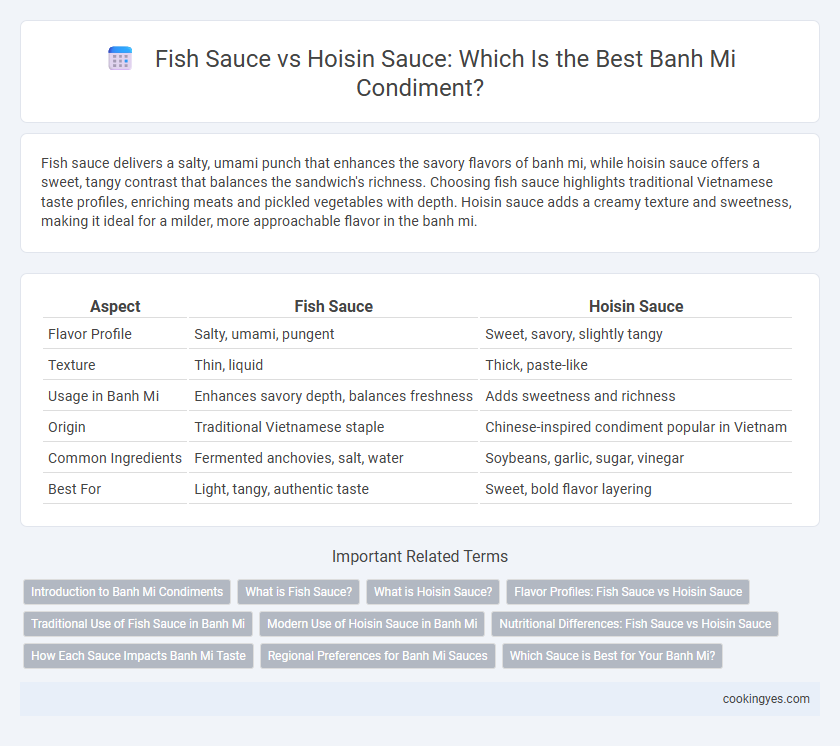Fish sauce delivers a salty, umami punch that enhances the savory flavors of banh mi, while hoisin sauce offers a sweet, tangy contrast that balances the sandwich's richness. Choosing fish sauce highlights traditional Vietnamese taste profiles, enriching meats and pickled vegetables with depth. Hoisin sauce adds a creamy texture and sweetness, making it ideal for a milder, more approachable flavor in the banh mi.
Table of Comparison
| Aspect | Fish Sauce | Hoisin Sauce |
|---|---|---|
| Flavor Profile | Salty, umami, pungent | Sweet, savory, slightly tangy |
| Texture | Thin, liquid | Thick, paste-like |
| Usage in Banh Mi | Enhances savory depth, balances freshness | Adds sweetness and richness |
| Origin | Traditional Vietnamese staple | Chinese-inspired condiment popular in Vietnam |
| Common Ingredients | Fermented anchovies, salt, water | Soybeans, garlic, sugar, vinegar |
| Best For | Light, tangy, authentic taste | Sweet, bold flavor layering |
Introduction to Banh Mi Condiments
Banh mi condiments play a crucial role in defining the sandwich's distinctive flavor, with fish sauce and hoisin sauce being two popular choices. Fish sauce contributes a savory, umami depth derived from fermented anchovies, enhancing the sandwich's authentic Vietnamese profile. Hoisin sauce offers a sweet and tangy contrast, adding complexity and balancing the flavors of meats and pickled vegetables in the banh mi.
What is Fish Sauce?
Fish sauce, a staple in Southeast Asian cuisine, is a fermented liquid made from anchovies and salt, prized for its intense umami flavor and salty depth. Its pungent aroma and savory taste provide a complex foundation that enhances the traditional Vietnamese banh mi sandwich. Unlike the sweeter, thicker hoisin sauce, fish sauce offers a bold, tangy contrast that elevates the overall flavor profile of the bread, meats, and pickled vegetables.
What is Hoisin Sauce?
Hoisin sauce is a thick, fragrant condiment made from fermented soybeans, garlic, vinegar, and sugar, commonly used in Vietnamese cuisine for its sweet and savory flavor profile. It adds a rich, slightly tangy taste to banh mi sandwiches, complementing the fresh herbs and pickled vegetables. Unlike fish sauce, which is salty and pungent, hoisin sauce provides a mellow sweetness that balances the sandwich's savory ingredients.
Flavor Profiles: Fish Sauce vs Hoisin Sauce
Fish sauce offers a salty, umami-rich flavor with a pungent aroma that enhances the savory depth of banh mi sandwiches. Hoisin sauce provides a sweet, tangy, and slightly spicy profile, contributing a rich, smooth texture that balances the freshness of pickled vegetables. Choosing between fish sauce and hoisin sauce depends on whether a distinct savory punch or a sweet-savory complement is desired for the banh mi experience.
Traditional Use of Fish Sauce in Banh Mi
Fish sauce serves as a fundamental traditional condiment in banh mi, imparting a distinctive umami depth that enhances the savory profile of the sandwich's Vietnamese heritage. Typically made from fermented anchovies, fish sauce is celebrated for its complex, salty, and slightly sweet flavor, which complements the fresh herbs, pickled vegetables, and grilled meats found in authentic banh mi. While hoisin sauce offers a sweeter, thicker alternative commonly enjoyed in fusion variations, the traditional essence of banh mi relies heavily on the pungent, savory character of fish sauce to maintain its authentic taste.
Modern Use of Hoisin Sauce in Banh Mi
Hoisin sauce has become a popular modern condiment in banh mi, offering a sweet, tangy flavor that complements the sandwich's savory elements. Unlike traditional fish sauce, hoisin adds a thicker, richer texture that enhances the overall taste profile without overpowering the fresh herbs and pickled vegetables. This shift reflects evolving palates and the fusion influence in contemporary Vietnamese cuisine, making hoisin a preferred choice for many banh mi enthusiasts.
Nutritional Differences: Fish Sauce vs Hoisin Sauce
Fish sauce is low in calories and carbohydrates but high in sodium, providing essential amino acids and minerals like calcium and magnesium that support metabolism and bone health. Hoisin sauce contains more sugar and calories, offering a sweeter flavor profile with added carbohydrates that may impact blood sugar levels, along with trace amounts of protein and fiber. Choosing between these condiments for banh mi depends on dietary goals, especially sodium intake and calorie control.
How Each Sauce Impacts Banh Mi Taste
Fish sauce adds a savory, salty depth to banh mi, enhancing the umami flavors of the meats and balancing the fresh herbs and vegetables with a pungent, slightly fermented tang. Hoisin sauce contributes a sweet, rich, and slightly spicy profile, creating a thicker, more complex glaze that complements the crispness of the pickled vegetables and soft baguette. The choice between fish sauce and hoisin sauce significantly influences banh mi's flavor, with fish sauce delivering a bold, traditional Vietnamese taste and hoisin sauce offering a sweeter, more mellow alternative.
Regional Preferences for Banh Mi Sauces
Fish sauce is a staple condiment in southern Vietnamese banh mi, offering a savory, umami-rich flavor that complements the pickled vegetables and grilled meats typical of the region. In contrast, northern Vietnamese banh mi often features hoisin sauce, which adds a sweet and slightly tangy dimension, reflecting the local palate's preference for milder, sweeter flavors. Regional variations in banh mi sauces highlight the cultural diversity within Vietnam's culinary traditions, with fish sauce dominating in the south and hoisin sauce preferred in the north.
Which Sauce is Best for Your Banh Mi?
Fish sauce offers a salty, umami depth that complements the savory pork and pickled vegetables in traditional banh mi, while hoisin sauce provides a sweeter, richer flavor that pairs well with grilled meats and adds a layer of complexity. Choosing the best sauce depends on your preference for either a pronounced, tangy accent from fish sauce or a subtle, sweet richness from hoisin. Many authentic recipes balance both sauces to achieve a harmonious flavor profile that enhances the overall banh mi experience.
Fish Sauce vs Hoisin Sauce for Banh mi condiment Infographic

 cookingyes.com
cookingyes.com